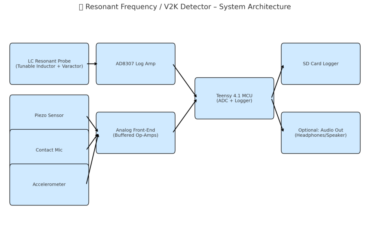
Resonance and Brainwaves
🔬 Understanding Resonance and Brainwave Modulation
Resonance is the phenomenon where a system oscillates with maximum amplitude at its natural frequency. Whether in physics, engineering, or biology, resonance has the power to dramatically amplify responses to small external inputs. In the context of brainwave interaction, this principle becomes a potential mechanism for influencing or even reading neural activity.
This guide explores all known theoretical methods to induce resonance, with a specific focus on how they might be adapted for brainwave entrainment or modulation. We’ll also cover how high-frequency systems like a 1.3 GHz comb signal might be transformed into brainwave-resonant patterns using signal processing and electromagnetic techniques.
🎵 A Simple Example: Tuning Forks for Resonance
To understand resonance in simple terms, imagine two tuning forks that are the same size and tuned to the same frequency. If you strike one fork, the other will start vibrating even though you didn’t touch it. That’s because the sound waves from the first fork match the natural frequency of the second — they’re in resonance.
💡 “Dumb person” version: It’s like yelling at your microwave with just the right pitch that it starts humming back at you. You didn’t touch it, but it starts reacting just because the sound matched something inside it.
This is what resonance does. It doesn’t take much power — just the right frequency — and the target starts vibrating, reacting, or syncing up on its own.
🔁 Methods for Achieving Resonance
1. Direct Frequency Matching (Entrainment)
- Concept: Applying an external signal that matches the natural frequency of a system (e.g., alpha brainwaves at 10 Hz).
- Examples: Binaural beats, flashing lights (photic stimulation), electromagnetic pulses.
2. Parametric Resonance
- Concept: Varying internal parameters (e.g., capacitance, stiffness) at twice the natural frequency to create resonance.
- Theoretical Use: Modulating neurotransmitter responses or brain conductivity via periodic field stimulation.
3. Heterodyning (Frequency Mixing)
- Concept: Combining two signals to produce a third signal (the beat frequency) that matches the target resonance.
- Application: Use a 1.33 GHz signal and its neighboring tooth in a frequency comb to produce a 10 Hz difference wave.
4. Feedback Mechanisms
- Concept: Using a closed-loop system where output re-enters as input to reinforce specific frequencies.
- Application: Neurofeedback and brain-computer interfaces (BCIs).
5. Forced Oscillation
- Concept: Driving a system with a periodic force at its natural frequency.
- Application: Transcranial magnetic stimulation (TMS) at beta frequencies to enhance focus.
6. Structural Modifications
- Concept: Adjusting the system’s physical properties to shift its resonant frequency.
- Use: Adjusting sensor placement, coil positioning, or antenna configuration.
7. Energy Transfer and Coupling
- Concept: Using two systems with near-identical frequencies to transfer energy.
- Application: Coupled resonant coils for transcranial capacitive coupling.
8. Synchronization (Phase Locking)
- Concept: Locking the phase of an external signal to the natural oscillation of the brain.
- Tool: Lock-in amplifiers in EEG systems.
9. Inductive or Capacitive Coupling
- Concept: Magnetic or electric field interaction without direct contact.
- Tool: TMS and tDCS for direct brain modulation.
10. External Excitation
- Concept: Mechanical or electrical stimulation of brain-adjacent tissue.
- Method: Vibrational excitation of the throat for subvocal resonance.
11. Wave Interference
- Concept: Aligning waves to create constructive interference.
- Application: Phased-array RF signals creating standing waves at 6 Hz.
🧠 Best Methods to Modulate Brainwaves
Theoretically, the best methods for resonating with or modifying brainwaves include:
- Direct Frequency Matching (Entrainment)
- Heterodyning (to generate delta/theta/alpha waves)
- Feedback Systems (like neurofeedback)
- Inductive/Capacitive Coupling (TMS/tDCS)
🔧 Using a 1.33 GHz Frequency Comb to Target Brainwaves
✅ Step 1: Generate the Comb
A comb is a broadband RF signal with evenly spaced “teeth” (frequencies). At 1.33 GHz, you may have teeth separated by 14 kHz or similar.
✅ Step 2: Use Heterodyning to Create Beat Frequencies
By mixing two teeth:
- Comb tooth A: 1.330000 GHz
- Comb tooth B: 1.330010 GHz
- Resulting difference = 10 kHz
Then mix this 10 kHz signal with another low-frequency source to downconvert to alpha or theta bands.
✅ Step 3: Induce Resonance in Biological Tissue
High-frequency signals can induce resonance via:
- Mechanical coupling: e.g., throat or vocal folds
- Thermal modulation: localized heating produces micro-vibrations
- Dielectric stimulation: RF interacts with tissue conductivity
✅ Step 4: Focus and Detect
Resonant detection doesn’t require downconversion if the tissue’s resonance is strong enough. Sensors can pick up:
- Electromagnetic phase shifts
- Mechanical oscillations
- Heat fluctuation patterns
⚠️ Key Challenges
- Skin depth: GHz frequencies are shallow; deeper penetration needs modulation.
- Precision tuning: Resonance requires exact frequency alignment.
- Environmental noise: False positives or losses due to background EM.
🧪 Conclusion: Resonance Is Real, and It’s Powerful
Resonance isn’t just a physics curiosity — it’s the mechanism behind real brainwave entrainment, neurostimulation, and even potential remote influence. Whether through heterodyned RF, entrainment signals, or phase-locked fields, the ability to align an external signal with a biological rhythm opens up massive potential — and risks.
For researchers and engineers working at the edge of neurotechnology, resonance is both the weapon and the key.

